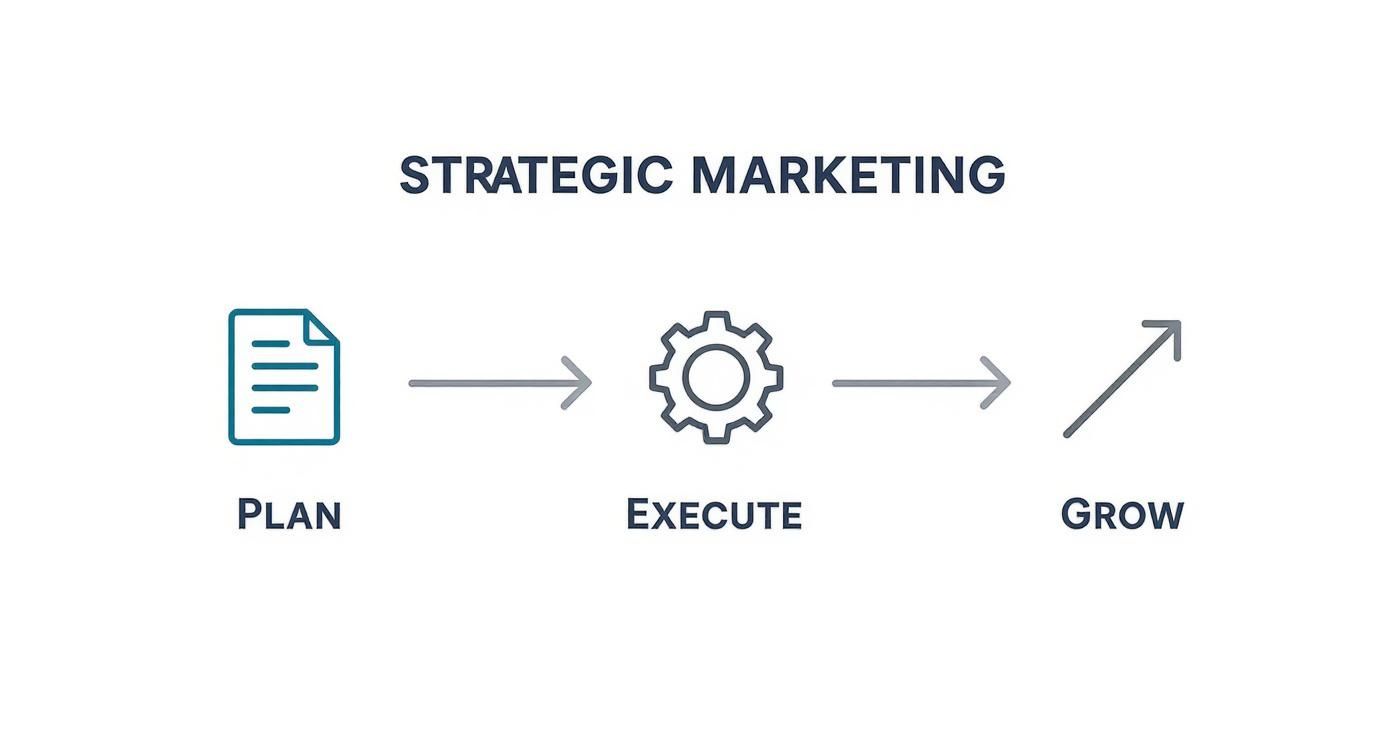Master the Strategic Marketing Planning Process
A strategic marketing plan isn't some dusty binder you create once and then forget on a shelf. It’s the living, breathing game plan that points your entire business toward real, sustainable growth.
This isn't just about running a few ads. It’s about transforming marketing from a series of random, reactive tactics into a proactive engine that builds a genuine competitive advantage.
What Strategic Marketing Planning Really Means Today
Let’s cut through the jargon. A real strategic plan aligns every single decision you make—from sales and customer service right down to product development. For any business that wants to do more than just keep the lights on, it’s non-negotiable. Think of it as your essential roadmap in a seriously crowded marketplace.
From Budgeting To A Living Strategy
The whole idea of a "strategic plan" has changed dramatically over the years. This process actually got its start back in the 1950s, evolving from simple annual budget planning. At first, companies were just focused on financial controls. But as markets exploded in the 1960s, businesses needed a much more forward-thinking approach. If you're a history nerd, Oregon State University has some great insights on how it all evolved.
Today, the process boils down to a few core components that every successful marketer I know lives by:
- Situational Analysis: Getting brutally honest about your internal strengths and what’s actually happening in the market outside your four walls.
- Goal Setting: Defining clear, measurable goals that you can trace directly back to revenue. No fuzzy metrics allowed.
- Strategy Formulation: Deciding how you’re going to win. This is where you lock in on your target audience and carve out your unique position in the market.
- Tactical Execution: Translating that high-level strategy into a concrete action plan with specific channels, campaigns, and deadlines.
This isn't a one-and-done deal. It's a continuous loop of planning, doing, and learning, which is what keeps your business agile.

As the infographic shows, it’s all about creating a cycle. You plan, you execute, you measure, and you grow—then you do it all over again, but smarter this time.
To make this crystal clear, it's crucial to understand that your high-level strategy is not the same as your day-to-day tactics. One is the 'why,' the other is the 'how.'
Strategic Plan vs Tactical Plan A Quick Comparison
| Time Horizon | Long-term (3-5 years) | Short-term (days, weeks, months) |
|---|---|---|
| Focus | The "Why" & "What" | The "How" & "When" |
| Scope | Broad, big-picture goals | Narrow, specific actions |
| Example | "Become the #1 CRM for small businesses." | "Launch a 3-month LinkedIn ad campaign targeting SaaS founders." |
| Responsibility | Leadership, C-Suite | Marketing teams, specialists |
| Flexibility | Stable, changes infrequently | Agile, adjusted often |
Mixing these two up is a classic mistake. Your strategy is your North Star; your tactics are the individual steps you take on the journey to get there.
The True Purpose Of Your Marketing Plan
A well-crafted plan does more than just list out promotions. It creates a unified vision that gives every single person on your team purpose and direction. Without one, you’re just throwing spaghetti at the wall, wasting resources, and praying something sticks.
A great plan is the difference between being busy and being productive. It ensures that every dollar spent and every hour worked pushes the business toward a clearly defined goal, turning marketing into a predictable revenue driver instead of an unpredictable expense.
This disciplined approach forces you to make tough, deliberate choices about where you’ll play and how you’ll win. It's about building a repeatable system that consistently attracts, converts, and keeps the right customers—laying a foundation that will pay off for years to come.
Building Your Foundation with Situational Analysis
Every great marketing strategy starts with a dose of reality. Before you can dream up a brilliant campaign, you have to get an unflinching look at where you actually stand today. This is the whole point of a situational analysis—it’s about gathering intelligence so your entire marketing plan is built on facts, not wishful thinking.
Skip this step, and you're basically marketing with a blindfold on. You might get lucky, sure. But more often than not, you'll burn through your budget on tactics that just don't land because they weren't connected to the real world.
Looking Inward and Outward with a SWOT Analysis
The classic SWOT analysis (Strengths, Weaknesses, Opportunities, Threats) is still a cornerstone of strategic planning for one simple reason: it works. It’s a straightforward framework that forces you to look in the mirror and then out the window. The only rule? Be brutally honest.
- Strengths (Internal): What are you genuinely great at? This isn't about ego—it's about assets. Maybe you have a patented technology, a ridiculously talented team, or a brand that people truly love. A real-world example might be your "proprietary algorithm that reduces customer churn by 15%."
- Weaknesses (Internal): Where are the cracks in the foundation? Be real about your limited resources, skill gaps, or that clunky old CRM that everyone hates. A weakness could be "an outdated CRM system that prevents effective lead nurturing."
Once you’ve got a clear picture of your internal world, it's time to look outward.
- Opportunities (External): What's happening out there that you can jump on? This could be anything from a new social media platform blowing up to a competitor's embarrassing PR fumble.
- Threats (External): What could derail you? Think about new competitors popping up, economic downturns, or shifts in what your customers actually want.
The magic of a SWOT analysis isn't in the list itself, but in connecting the dots. How can you use your strengths to seize those opportunities? And how do you shore up your weaknesses to guard against threats? This is where raw data starts looking a lot like a battle plan.
Understanding the Broader Market with PESTLE
While SWOT keeps you focused on your immediate surroundings, a PESTLE analysis is like pulling out a telescope. It helps you zoom out and see the bigger, macro-level forces at play by examining Political, Economic, Social, Technological, Legal, and Environmental factors.
This kind of big-picture thinking isn't just an academic exercise. It became essential back in the 1970s when major economic shocks made old-school business forecasting useless. Companies learned the hard way that they had to constantly scan the horizon for trends that could change the game overnight.
A situational analysis isn't about creating a 100-page report nobody will read. The goal is to find the 3-5 most critical insights that will shape everything you do next. Don't get lost in the data—look for the story it's telling you.
Decoding Your Competitors' Game Plan
A real competitor analysis is so much more than a quick glance at a rival’s pricing page. Your mission is to reverse-engineer their strategy to find the gaps they've left wide open for you. Don't just list what they do; figure out why they're doing it.
Here’s where to focus your detective work:
Positioning and Messaging: How do they talk about themselves? Who are they trying to reach? What problems do they claim to solve? This tells you how they want to be seen.
Customer Voice: What are their customers really saying? Dive into review sites, Reddit threads, and social media comments. This is where you’ll find their true weaknesses—the promises they aren't keeping. Actively analyzing customer feedback is a goldmine for insights that can directly sharpen your own strategy.
Content and Channel Strategy: Where are they spending their time and money? Are they all-in on SEO-driven blogs, creating viral videos, or building a community on a specific platform? This shows you where they think their audience lives.
If you want to get into the nitty-gritty tools and techniques, check out our guide on how to conduct a competitor analysis to gain a serious edge. This intelligence is your secret weapon. It lets you position your brand to directly counter their weak spots while shining a spotlight on what makes you unique.
Defining Your North Star with Goals and KPIs

You’ve done the analysis and mapped the battlefield. Now comes the critical part: deciding what winning actually looks like. A marketing plan without clear, measurable goals is just a list of expensive hobbies. You'll be busy, sure, but you'll be spinning your wheels without getting anywhere meaningful.
This is where we ditch vague aspirations like "increase brand awareness" and start talking about tangible business outcomes. Your marketing objectives can't exist in a silo; they need to be a direct reflection of the company's biggest goals. There should be a straight line connecting every campaign you run back to revenue, growth, or market share.
From Business Goals to SMART Marketing Objectives
The most effective marketing strategies cascade down from the top. If the CEO's primary goal is to boost annual recurring revenue (ARR) by 30%, your marketing objectives can't be about getting more social media followers. They have to tie directly to that revenue target.
This is where the SMART framework becomes your best friend. It’s a simple but brutally effective filter for turning fuzzy wishes into solid goals.
- Specific: Nail down exactly what you want to accomplish. "Get more leads" is a hope. "Generate 500 new marketing qualified leads (MQLs) from the manufacturing sector" is a plan.
- Measurable: How will you prove you did it? This means having the right analytics and tracking in place before you even start.
- Achievable: Be ambitious, but don't set your team up for failure. A goal should stretch you, not break you.
- Relevant: Does this goal actually support the bigger business objective? Yes, generating 500 MQLs absolutely helps hit that 30% ARR target.
- Time-bound: Give yourself a deadline. "Generate 500 new MQLs in Q3" creates urgency and a clear finish line.
This structured approach transforms abstract goals into a concrete action plan. It’s the difference between hoping for results and engineering them.
Selecting KPIs That Actually Matter
Once your SMART objectives are set, you need the right Key Performance Indicators (KPIs) to track your progress. KPIs are the specific metrics that tell you if you're on the right path to hitting your objective.
Think of it this way: your objective is the destination (New York City), and your KPIs are the gauges on your car's dashboard (speed, fuel, engine temp). They let you know if you're actually going to make it.
The real skill in selecting KPIs is picking the few vital metrics that predict success, not the many trivial ones that just create noise. You want to focus on leading indicators that show future success, not just lagging indicators that report on what already happened.
For example, a high click-through rate (CTR) on an ad feels good, but it's a vanity metric if those clicks aren't turning into customers. A far more meaningful KPI would be Cost Per Acquisition (CPA) or the Conversion Rate from that campaign.
Marketers have been obsessed with measurement for decades. We went from using the basic marketing mix (product, price, place, promotion) to building complex marketing mix models (MMM) to prove our worth with statistical analysis. This history of data-driven decision-making is nothing new, as you can see in this deep dive on the history of marketing analytics from Marketing Evolution.
Putting It All Together with Real-World Examples
Connecting high-level business goals to specific objectives and KPIs is the absolute core of a strategic marketing plan. It’s what separates the pros from the amateurs.
To make this crystal clear, here’s a table showing how this looks in practice for different types of businesses.
Example Marketing Objectives and Corresponding KPIs
| Increase customer retention by 15% (SaaS) | Reduce monthly customer churn from 3% to 2% by the end of the fiscal year. | Monthly Churn Rate |
|---|---|---|
| Grow online sales by 25% (E-commerce) | Increase the average order value (AOV) from $75 to $95 within six months through targeted upselling campaigns. | Average Order Value (AOV) |
| Expand into a new market segment (B2B Services) | Acquire 20 new enterprise-level clients in the financial services industry in the next 12 months. | Customer Acquisition Cost (CAC) |
When you define these elements with this level of precision, you build a system of accountability. Every single person on your team knows exactly what they're working toward and how their contribution will be measured. This ensures the entire marketing engine is pulling in the same direction—straight toward that North Star.
Crafting Your Strategy with Audience and Positioning

Alright, you've got your goals locked in. Now comes the fun part: figuring out exactly how you’re going to win. A winning strategy isn't about being everything to everyone. It's about being the absolute perfect choice for a specific group of people who desperately need what you're selling.
This is the heart of the strategic marketing process—where you stop analyzing and start acting. It’s where you define your customer with razor-sharp clarity and then carve out a unique space for your brand in their mind. Forget shouting the loudest; this is about saying the right thing to the right person.
The old-school idea of mass marketing, where you just blast a single message to the entire world, is a fossil. As markets got more crowded, the game shifted from reaching everyone to connecting deeply with someone.
Moving Beyond Simple Demographics
Knowing your audience’s age and location is a start, but it's table stakes. True market segmentation goes way deeper. You need to understand the why behind their decisions. What makes them tick?
This means digging into psychographics and behaviors. What do they actually value? What problems keep them up at night? Where do they hang out online when they need advice? Answering these questions is how you transform a vague "target market" into a well-defined audience you can actually talk to.
Effective segmentation means looking at:
- Behavioral Data: How are people interacting with your site? What are they buying? How often do they come back?
- Psychographic Insights: What's their lifestyle? What are their core values, interests, and opinions?
- Needs-Based Grouping: What specific problems are they trying to solve or benefits are they chasing?
Getting this level of detail lets you tailor your messaging so it feels like you're speaking directly to them, not just broadcasting to a faceless crowd.
Developing Buyer Personas That Feel Real
Once you’ve sliced up your market into segments, the next move is to bring those segments to life with buyer personas. A persona is a semi-fictional character that represents your ideal customer. But it’s not just a boring list of attributes; it’s a story.
A great persona gives this abstract customer a name, a job title, goals, and very real challenges. For example, instead of targeting "small business owners," you create "Startup Steve." He's a 35-year-old founder who's totally overwhelmed by admin tasks and desperately needs a tool to automate his invoicing. See? Now you have a real person to market to.
When you're building out these personas, get specific about the problems they face. This is where you can learn how to create buyer personas that will guide your entire content and product strategy. Once you truly understand "Steve's" pain points, you can craft messaging that speaks directly to his frustrations and offers a clear, no-brainer solution.
Carving Out Your Unique Position in the Market
With a crystal-clear picture of who you're talking to, you can finally define your brand positioning. This is the distinct space you want to own in your customer's mind, especially compared to your competitors. It’s the simple answer to the question: "Why the hell should I choose you?"
Your positioning statement is an internal guide that shapes every single external message. It’s not a tagline you slap on an ad; it’s the core idea behind your brand. A strong positioning strategy can turn a product that seems like a commodity into a category leader just by highlighting a unique, powerful angle.
Think about a B2B software company. Instead of saying, "We sell project management software," their positioning might be, "We provide the only project management tool designed specifically for non-technical creative agencies to simplify client approvals." That’s sharp, specific, and memorable.
Positioning is a strategic choice to be known for one thing. It’s about making tradeoffs and having the discipline to say no to being everything, so you can be something special to a focused audience.
This whole process is a core piece of building a successful go-to-market plan. As you put your strategy together, think about how you can develop a robust B2B go-to-market strategy framework that gets your entire company rallied around this central positioning.
Crafting a Compelling Value Proposition
Your positioning is ultimately brought to life through your unique value proposition (UVP). This is a clear, punchy statement that communicates the tangible benefit a customer gets from choosing you. No fluff, no jargon.
A powerful UVP should instantly answer three questions:
How do you solve my problem or improve my situation?
What specific benefits can I expect?
Why should I buy from you and not the other guy?
For instance, the note-taking app Evernote once used the simple but brilliant UVP: "Remember Everything." In just two words, it perfectly captured the benefit and the solution. Your UVP is the promise you make to your customers, and every piece of marketing you create should be working to deliver on it.
Turning Your Strategy into Action

This is it. The moment of truth. All that research, goal-setting, and head-scratching culminates right here—where your grand vision gets its hands dirty and becomes an actual plan of attack.
Let's be real: a strategy without an action plan is just a good idea. And good ideas don't pay the bills.
The goal now is to translate your big-picture thinking into a concrete, integrated set of activities. Every channel, every campaign, every piece of content has to work together, each one reinforcing the others to create a smooth customer experience that inches you closer to your goals.
Historically, this is where things have fallen apart for a lot of companies. For decades, marketing was treated as a simple sales-support function instead of a core strategic driver, which hamstrung growth. As Marketing Evolution explains, today's winners are the ones who weave financial, operational, and customer-facing tactics into a single, unified action plan.
Modernizing the Classic Marketing Mix
To build out your plan, we can lean on an old-school framework: the classic '4 Ps' of marketing—Product, Price, Place, and Promotion. But we need to give it a modern, digital-first spin. Think of it as a practical checklist to make sure you've covered all your bases.
- Product: How will you talk about what you sell? This is everything from your core messaging and branding to the user experience on your site. Your plan needs to spell out how these elements show up across every channel.
- Price: This covers your pricing strategy, plus any discounts, promos, or special offers you plan to run. These need to be scheduled, budgeted for, and baked into the plan.
- Place: Where will customers actually find you? In the digital world, "place" is your website, your social media profiles, the search results page, and their email inbox. Your plan has to pinpoint which channels you'll focus on.
- Promotion: This is the part everyone sees. It’s all your communication tactics—content marketing, SEO, paid ads, PR, and social media campaigns.
Your job is to define specific, actionable tasks within each of these buckets that ladder up to your main strategy. If you want a full breakdown of what goes into each campaign, you can check out our guide on using a marketing campaign planning template to keep it all organized.
Building an Integrated Channel Strategy
Your customers don't live on a single channel, so your marketing shouldn't either. An integrated strategy is all about making your chosen channels play nicely together. Your SEO efforts should feed your content topics, your social media ads should push traffic to key landing pages, and your email marketing should nurture the leads you get from all of them.
For example, a B2B software company might map out these integrated moves:
Content Marketing: Publish a monster guide on a major industry pain point.
SEO: Optimize that guide to rank for high-intent keywords, pulling in organic traffic.
Paid Social: Run targeted ads on LinkedIn promoting the guide to specific job titles to capture leads.
Life Cycle Marketing: Nurture those fresh leads with an automated email sequence that offers more value and eventually introduces the software.
Each tactic supports the others, creating a powerful system that does more than the sum of its parts. This is how you get maximum bang for your buck.
The best action plans don't just list tactics; they orchestrate them. Think of yourself as a conductor, making sure every instrument (channel) plays its part at just the right time to create a beautiful piece of music (the customer journey).
Tackling the Marketing Budget
No action plan is real until it has a budget. This is where you put your money where your mouth is. Without a clear budget, you're just guessing where to invest your time and cash.
While there are a few ways to slice this, one of the smartest is the objective-and-task method.
Instead of pulling a number out of thin air or just adding 5% to last year's spend, this method works backward from your goals. You outline what you want to achieve, identify the specific tasks needed to get there, and then figure out how much it'll all cost. It forces your budget to be directly tied to your strategy.
Here’s how it works:
Define Your Objective: "Acquire 200 new customers in Q4."
List the Tasks: To do that, you figure you'll need to run a Google Ads campaign, publish four new case studies, and launch a referral program.
Estimate Costs: You calculate the ad spend for Google, the content creation costs for the case studies, and the expense of the referral incentives.
Set the Budget: The sum of those costs becomes your marketing budget.
This approach turns budgeting from a guessing game into a strategic investment. Every single dollar is allocated with a purpose and an expected return, giving you a clear justification for your spending and focusing your resources where they'll make the biggest impact.
Common Questions About Strategic Marketing Planning
Let's be real—moving from a marketing plan on paper to making it work in the real world is where things get interesting.This is where the tough questions pop up. I get asked these all the time, so let's walk through the most common ones.
How Often Should We Review Our Strategic Marketing Plan?
A marketing plan should be a living document, not a dusty binder on a shelf. Your big-picture strategy—your core mission and long-term vision—can probably hold steady for three to five years. But the plan you use day-to-day? That needs a much closer look, much more often.
You absolutely need to do a major review annually. This is your moment to zoom out, check on the competition, see what’s changed in the market, and measure how you did against your big goals for the year.
But your tactical plan—the actual campaigns, channels, and KPIs—demands more frequent check-ins. Think quarterly or even monthly. This is what keeps you agile. It lets you double down on what’s working and kill what isn’t without waiting a whole year to find out you wasted a ton of money.
Your strategy is your destination, but your tactics are the route you take. The destination rarely changes, but you might need to find a new route if you hit a roadblock. Constant monitoring lets you stay agile and make smart detours without getting lost.
This constant pulse-check allows you to pivot based on campaign data, react to a competitor’s surprise move, or jump on a new opportunity. You stay on course without being rigid.
What Is the Biggest Mistake Companies Make in This Process?
I see this one all the time, and it's a killer: creating a marketing plan in a vacuum, completely disconnected from what the business is actually trying to achieve.
Too many plans get bogged down in vanity metrics—chasing social media likes or traffic spikes—without connecting those activities to what really moves the needle: revenue, customer lifetime value, or market share. A great plan doesn't just list marketing activities; it justifies them.
A truly strategic plan always starts by asking, "What are our primary business goals?" From there, every single marketing objective is built to directly support those outcomes. Every tactic has a "why" that ties back to the bottom line.
Another massive misstep? Skipping the research and analysis. Jumping straight to tactics without really understanding your customers, your competitors, or your own unique strengths is like trying to drive to a new city without a map. You'll just burn gas and get nowhere.
How Can a Small Business Implement This Process?
This whole process is not just for giant corporations with massive teams. In fact, it's arguably more critical for a small business where every dollar and every hour counts. The key for smaller teams is one simple but powerful word: focus.
Don't try to be everywhere. Your analysis should help you pinpoint a specific, underserved niche where you can actually win. Your goals need to be ruthlessly focused and realistic. Avoid the temptation to chase every shiny new trend.
For your budget, the "objective-and-task" method is your best friend. It’s a straightforward, no-fluff approach:
- First, define your single most critical goal. Maybe it's landing 20 new high-value clients this quarter.
- Next, identify the most cost-effective tactics to hit that goal. This could be hyper-targeted local SEO and a killer customer referral program.
- Then, build your budget around those specific activities and nothing else.
This discipline gives you the power to say "no" to all the distractions that will inevitably come your way. It ensures every dollar you spend is a calculated investment, not just a shot in the dark. It’s about making smarter, more concentrated bets to get real, measurable growth.
Ready to stop guessing and start growing? The expert team at Rebus builds data-driven strategic marketing plans that deliver real results. We dive deep into your business to craft a roadmap that aligns with your unique goals, ensuring every marketing dollar you spend is an investment in your success. Partner with us to transform your brand’s potential into measurable growth.
